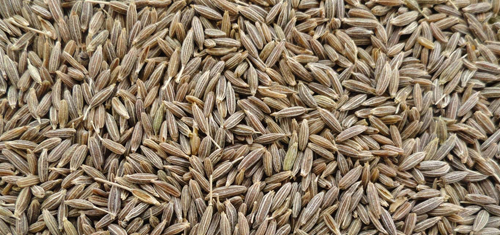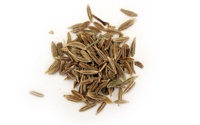Cumin Seed
Cumin Seed
Pronounced: que-min

An aromatic spice with a distinctive bitter flavor and strong, warm aroma due to its abundant oil content. Cumin “seeds” are actually the small dried fruit of an annual plant in the parsley family. Native to the Mediterranean, cumin is hotter to the taste, lighter in color, and larger than caraway, another spice it’s sometimes confused with. Sold whole or ground, the seeds come in three colors: amber, white or black. Amber is most widely available, but the black has such a complex flavor it should not be substituted for the other two. Cumin is a popular ingredient in Middle Eastern, Asian, Mediterranean and Mexican cuisines, and is one of the main ingredients in curry powder.
What Is Cumin Seed?
 The scientific name for cumin isCuminum cyminum. Although the small cumin seed looks rather unassuming, it packs a punch when it comes to flavor, which can be described as penetrating and peppery with slight citrus overtones. Cumin’s unique flavor complexity has made it an integral spice in the cuisines of Mexico, India and the Middle East.
The scientific name for cumin isCuminum cyminum. Although the small cumin seed looks rather unassuming, it packs a punch when it comes to flavor, which can be described as penetrating and peppery with slight citrus overtones. Cumin’s unique flavor complexity has made it an integral spice in the cuisines of Mexico, India and the Middle East.
Plant and Cultivation
Cumin is grown from seeds. The seeds need 2 to 5 °C (36 to 41 °F) for emergence, an optimum of 20–30 °C (68–86 °F) is suggested. Cumin is vulnerable to frost damage, especially at flowering and early seed formation stages. Methods to reduce frost damage are spraying with sulfuric acid (0.1%), irrigating the crop prior to frost incidence, setting up windbreaks, or creating an early morning smoke cover. The seedlings of cumin are rather small and their vigor is low. Soaking the seeds for 8 hours before sowing enhances germination. For an optimal plant population a sowing density of 12–15 kilograms per hectare (11–13 lb/acre) is recommended. Fertile, sandy, loamy soils with good aeration, proper drainage and high oxygen availability are preferred. The pH optimum of the soil ranges from 6.8 to 8.3. Cumin seedlings are sensitive to salinity and emergence from heavy soils is rather difficult. Therefore, a proper seedbed preparation (smooth bed) is crucial for optimal establishment of cumin.
Two sowing methods are used for cumin, broadcasting and line sowing. For broadcast sowing, the field is divided into beds and the seeds are uniformly broadcast in this bed. Afterwards, they are covered with soil using a rake. For line sowing, shallow furrows are prepared with hooks at a distance of 20 to 25 cm (8 to 10 in). The seeds are then placed in these furrows and covered with soil. Line sowing offers advantages for intercultural operations such as weeding, hoeing, or spraying. The recommended sowing depth is 1–2 cm and the recommended sowing density is around 120 plants per square metre. The water requirements of cumin are lower than those of many other species. Despite this, cumin is often irrigated after sowing to be sure that enough moisture is available for seedling development. The amount and frequency of irrigation depends on the climate conditions.
Description
Cumin is the dried seed of the herb Cuminum cyminum, a member of the parsley family. Cumin seeds resemble caraway seeds, being oblong in shape, longitudinally ridged, and yellow-brown in color. This is not surprising as both cumin and caraway, as well as parsley and dill, belong to the same plant family (Umbelliferae). The cumin plant grows to 30–50 cm (12–20 in) tall and is harvested by hand. It is an annual herbaceous plant, with a slender, glabrous, branched stem which is 20–30 cm (8–12 in) tall and has a diameter of 3–5 cm (1 1⁄4–2 in).[9] Each branch has two to three sub-branches. All the branches attain the same height, therefore the plant has a uniform canopy.The stem is coloured grey or dark green. The leaves are 5–10 cm (2–4 in) long, pinnate or bipinnate, with thread-like leaflets. The flowers are small, white or pink, and borne in umbels. Each umbel has five to seven umbellts. The fruit is a lateral fusiform or ovoid achene 4–5 mm (1⁄6–1⁄5 in) long, containing two mericarpswith a single seed. Cumin seeds have eight ridges with oil canals.
Producing Countries of Cumin Seed
The main producer and consumer of cumin is India. It produces 70% of the world supply and consumes 90% of that (which means that India consumes 63% of the world’s cumin). Other producers are Syria (7%), Iran (6%) and Turkey (6%). The remaining 11% comes from other countries. In total, around 300,000 tons of cumin per year are produced worldwide.
Consuming Countries of Cumin Seed
The major cumin seed consuming countries that are India, Mexico, Portugal, Spain, Turkey, China, Japan, Netherlands, France and Morocco.
